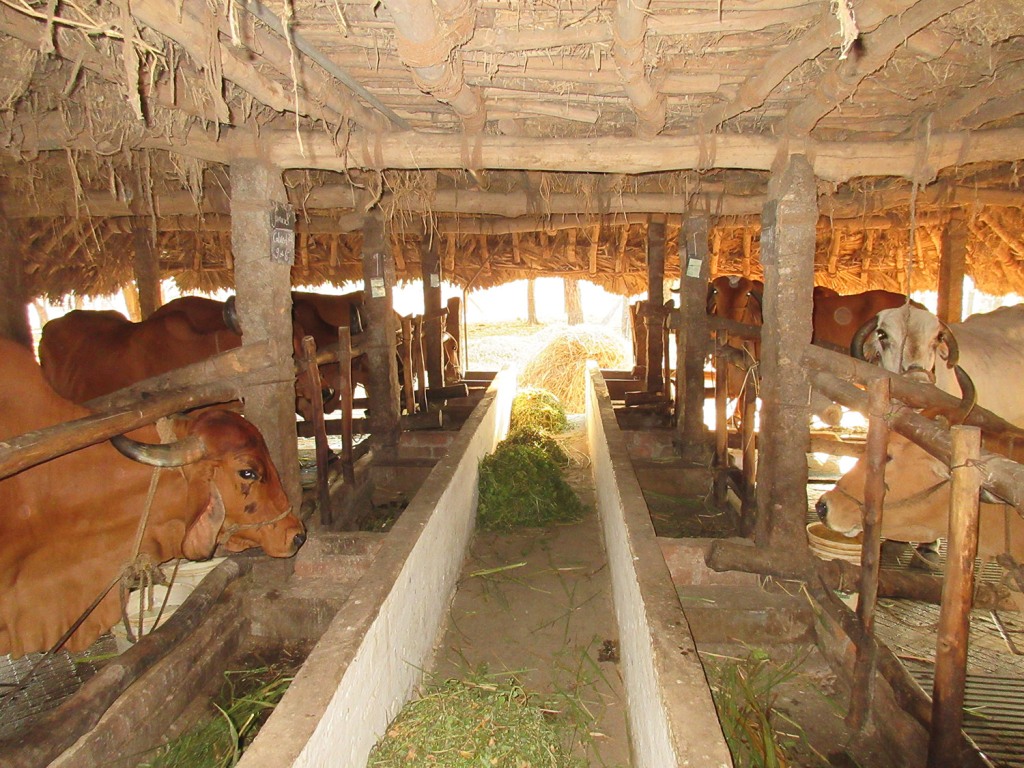The cows of Annapurna: in an interview with Tomas, one of Annapurna’s stewards.
The Dairy – It all began with “Puja”

The old shed

Deepa

Kiri

Suji
It was not long after Annapurna’s start in 1986, that the first cow appeared on the farm. She came from a nearby village. “I simply wanted to have some yoghurt and manure” says steward Tomas and smiles: ”So the calf and I shared the little amount of milk available”. With Bernard (an Aurovilian farmer) getting involved and having worked with cows, things started to change and the number of cows increased.
“In those first years we had quite a motley collection of cows from small local animals to majestic Girs, and everything in between. It took some years to find a clear direction in which way to move forward. In the end ‘Pundatti’ (local breed mixed with jersey) was mated with ‘Raman’ (pure Gir cow breed) which first produced Pamela and later Puja which were the kind of cows we were looking for. Puja became the mother animal of our current herd. Now after breeding for 30 years going through many generations of mother animals and bulls our herd is quite a unique mix and fit to the current farm conditions. This does not mean that the story ends here. With increasing labour cost/availability and increase of herd size the farm is exploring the possibility of machine milking. This means our breeding criteria need to include suitability of machine milking. The character of the cows has to be more docile with a certain teat size to fit the machine. All this will have to be introduced into the breeding program. The cow house needs to also be redesigned to be able to operate the machinery properly.
In 1993 a cowshed for 16 cows was built and in the years after a small shed followed for the calves and the heifers and young bulls. Every day the cows go out free grazing for a limited period of time. The animals are grazed throughout the farm with the help of a movable electric fence. In the wet season and spring, the herd is grazed in every nook and corner of the farm and rain fed field areas while in the dry summer time, if conditions are favourable, they are moved through the odd 100 rice plots which are having a green manure crop. In this way the dairy herd is integrated as much as possible in the farm; both animals and crops benefit and are dependent on each other. Today Annapurna dairy has at its disposal a fully functioning cheesery and a cool room. This has come a long way, where initially milk was all marketed directly, after which paneer was developed to take care of the evening milk. Then we developed a process to mature the paneer to be able to overcome the summer glut of milk in a low Auroville market. Only after the farm got its electricity connection more fresh cheeses were developed and ultimately Rennet cheese was added to the collection after having built a cool room. To develop the various cheeses, different people were involved who all brought in specific skills needed to create a quality product. This process is ongoing and we hope to develop more kinds of dairy products in the years to come. Since some time Nidhin, coming from Kerala and being in the process of joining the Auroville community, is managing the dairy processing area.
Since a few years the Indian hygiene standards organization (FSSAI) have been improved and imposed, which meant we had to separate the cheese processing from domestic activities and we created a small cheesery which complies to the current hygiene standards of India.
Most visitors admire the beauty of the Annapurna cows. With their long horns, their proud mighty look and their impressive height they show the strength of the original Gir breed but one sees also the different breeds bred into the herd. Since the herd is fully bred on the farm there is a strong sense of hierarchy and harmony.
Today Annapurna’s dairy consists of around 30 animals from which half are adult and milking, the rest being young stock and a bull for breeding. Cows are crossbred with mostly indigenous breeds and some jersey cow breed for improved milk yield.
We are in the process increasing the herd to 16 milking animals, and an extra shed has been built to house the young animals (and bull) to be able to select new members.
The demand for Annapurna’s dairy products is good. One of the reasons is the fact that Annapurna is a certified organic farm and people appreciate food safety and quality.”